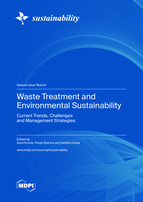Waste Treatment and Environmental Sustainability: Current Trends, Challenges and Management Strategies
A special issue of Sustainability (ISSN 2071-1050). This special issue belongs to the section "Environmental Sustainability and Applications".
Deadline for manuscript submissions: closed (10 April 2023) | Viewed by 24240
Special Issue Editors
Interests: solid and hazardous waste management; anaerobic digestion; phytoremediation; ecology and environmental engineering; industrial wastewater
Special Issues, Collections and Topics in MDPI journals
Interests: phytoremediation; bioremediation; metagenomics; waste management; treatment technology; industrial wastewater; metal detoxification
Special Issue Information
Dear Colleagues,
Scope and purpose
The continuous generation of waste from different sources, such as municipal solid waste, E-waste, plastic waste, construction and demolition waste and industrial waste and is highly loaded with different metals pollution parameters. Due to leaching properties of some pollutants, ground water pollution may be caused, affecting the human and environmental health. The use of phytoremediation and bioremediation approaches provides an ecologically sound, efficient, and environment-friendly and cost-effective strategy to the management of waste. The phytoremediation technologies for management play an important role in metals accumulation and pollution reduction. The use of heavy metals accumulation by the native and hyperaccumulators plant species growing on wastewater is the most straightforward strategy for phytoremediation, for which purpose, more than a hundred native plants have been reported to be useful. The analyzed plants investigated during this study presented biochemical factors and antioxidant enzymes which are significantly important for in situ phytoremediations. Therefore, these plants can be recommended for use in mass biotechnological processes to mitigate sites polluted by waste management. Among the different wastes, E-waste has been considered as secondary resources for obtaining metals, plastics, glass and ceramics. For recovering metals from E-waste, different techniques, such as hydrometallurgy, pyrometallurgy, electrometallurgy and the combination of these can be a good approach towards achieving sustainable development. The aim of this Special Issue is to bring together high quality original research and reviews highlighting the significant role of waste management and recycling in terms of environmentally safe disposal. Contributions should focus on the waste treatment techniques and mechanisms, where endless significant contributions can be made and can be of huge interest with respect to future research prospects.
(1) Outline the overall
a.Focus:
Numerous hazardous pollutants and metals are present in solid waste (municipal solid waste, E-waste, plastic waste, construction and demolition waste, etc.) that can directly affect the environment and human health. These pollutants are very hazardous and can generate highly toxic byproducts when disposed in the environment. The conventional methods for treatment and degradation of such kind of pollutants are not effective. To cope with the various problems generated for waste disposal, some processes, such as bioremediation, phytoremediation, and green technologies are usually accepted for achieving sustainable development.
b. Scope and Specific topics:
Academics, researchers, professional engineers and scientists are encouraged to submit their novel, and high quality scientific studies and reviews in terms of the following topics.
- Identification and profiling of pollutants from waste;
- Degradation of hazardous pollutants using green technology;
- Novel technologies for resource recovery from waste;
- Application of membrane technology in waste treatment process;
- Waste management and its application to achieve circular economy;
- Profiling of microbial community during bioremediation of waste management;
- Mechanism of phytoremediation for waste detoxification;
- Application of life cycle assessment (LCA) in solid waste management;
- Role of microorganisms in solid waste management.
c. Purpose
The aim of this Special Issue is to bring together high-quality original research and reviews highlighting the significant role of waste management and recycling for safe environmental disposal. Contributions should focus on the waste treatment techniques and mechanisms, where endless significant contributions can be made and can be of huge interest with respect to future research prospects.
(2) Suggest how the issue will usefully supplement (relate to) existing literature.
Innovative advanced treatments techniques for removal and degradation along with resource recovery of metals make a direct and positive impact on economic growth, the environment, and quality of life. Advanced approaches applied for improvement processes and products create several avenues to increasing sustainability. The issue must cover the current state of the art and future challenges in development of multifunctional strategy for energy and environmental applications. Full research papers and review articles are sought for this Special Issue.
Dr. Sunil Kumar
Dr. Pooja Sharma
Dr. Deblina Dutta
Guest Editors
Manuscript Submission Information
Manuscripts should be submitted online at www.mdpi.com by registering and logging in to this website. Once you are registered, click here to go to the submission form. Manuscripts can be submitted until the deadline. All submissions that pass pre-check are peer-reviewed. Accepted papers will be published continuously in the journal (as soon as accepted) and will be listed together on the special issue website. Research articles, review articles as well as short communications are invited. For planned papers, a title and short abstract (about 100 words) can be sent to the Editorial Office for announcement on this website.
Submitted manuscripts should not have been published previously, nor be under consideration for publication elsewhere (except conference proceedings papers). All manuscripts are thoroughly refereed through a single-blind peer-review process. A guide for authors and other relevant information for submission of manuscripts is available on the Instructions for Authors page. Sustainability is an international peer-reviewed open access semimonthly journal published by MDPI.
Please visit the Instructions for Authors page before submitting a manuscript. The Article Processing Charge (APC) for publication in this open access journal is 2400 CHF (Swiss Francs). Submitted papers should be well formatted and use good English. Authors may use MDPI's English editing service prior to publication or during author revisions.
Keywords
- microbial treatment technology
- emerging pollutants
- metals detoxification
- biotechnological approaches
- management and reuse
- resource recovery
- value added products








